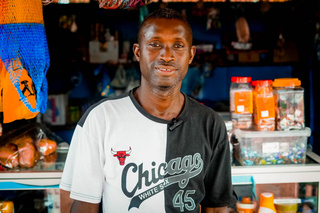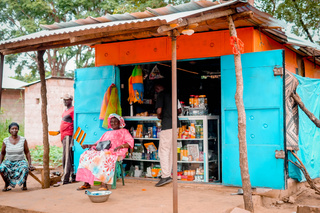share

Famara Sané in front of his shop, opened in August 2023 in Bissine. | © A. Faye / HI
Famara comes from Bissine, a village in Senegal from which he was forced to flee in 1992. Thirty years later, he can finally return to his land, made safe by HI's demining teams.
In the 1990s, during the conflict between fighters from the Mouvement des forces démocratiques de la Casamance [Movement of Democratic Forces of Casamance] and the Senegalese army, Bissine, a prosperous village in Casamance, was the scene of terrible violence. From one day to the next, the inhabitants were forced to flee their homes, destroyed by bombs. Their exile lasted thirty years, before the area was made safe by HI's demining teams and they were able to return to their ancestral homeland.
Famara Sané was born and raised in a large family in Bissine. He was 17 on Friday 9 October 1992, the day that changed the lives of Bissine’s inhabitants. As he was at secondary school in Ziguinchor during the week, only going home at weekends, he learnt the news from a friend.
 "In those days, there were no telephones. We got the information in dribs and drabs. My friend told me that my little brother had been hit in the knee and that my older sister had had to carry him out on her back. I was told that there had been deaths... It was only three days later that I learned my parents were safe and had taken refuge in Guinea-Bissau," he recalls.
"In those days, there were no telephones. We got the information in dribs and drabs. My friend told me that my little brother had been hit in the knee and that my older sister had had to carry him out on her back. I was told that there had been deaths... It was only three days later that I learned my parents were safe and had taken refuge in Guinea-Bissau," he recalls.
Famara stayed in Ziguinchor until he passed his baccalaureate and then moved to Dakar to study. He only joined his family for special occasions.
"I would have liked to stay and live in Bissine. Even after we left, we organised ourselves into sections of former inhabitants of the village. We always talked about our hope of returning one day, and the associations worked tirelessly to make it happen."
In 2020, Famara learned that some families were starting to return to Bissine. He was one of the first to move back to the village.
"We came back in convoys, and people joined us on the road. We started to clear the weeds and reclaim our land. It was hard work, but we didn't feel the pain because it was a dream come true."
However, mines and explosive devices were still a real threat. In response to a growing demand from the people returning to Bissine and wishing to take back their land, the National Mine Action Centre decided to call on HI's demining teams to make the land safe. Between July and October 2022, the teams released almost 95,000 m² of land back to the villagers and destroyed 15 explosive devices.
 Once settled, Famara's first idea was to build a hardware store because "we need cement to rebuild the village". But his wife was more in favour of a shop to supply the whole community. This was the project they chose.
Once settled, Famara's first idea was to build a hardware store because "we need cement to rebuild the village". But his wife was more in favour of a shop to supply the whole community. This was the project they chose.
"There was a real need - people had to travel a long way to do their shopping. We opened the shop in August 2023. Since then, everyone has been coming here. We take customer orders and fill them."
But Famara, who works in the shop with his older sister, has not given up on his plan for a hardware store. He is currently negotiating with delivery drivers and hopes to open his new store soon. In the meantime, he is handling applications for plots of land from people wishing to return to Bissine.
"We're making a list of the sons and daughters of the village who want to come back; we already have more than 800 applications. We're firm believers. We're certain that someday all these uncultivated plots of land that you see around you will be homes," he concludes.
Senegal estimates the extent of contamination linked to the conflict in Casamance at 1,200,000 m² of land, spread over five departments. In May 2022, HI relaunched its demining operations in Casamance, where the organisation had already cleared more than 900,000 m² of land since 2008. HI's current two projects will clear 800,000 m² of land by 2025, helping to restore security and socio-economic prosperity to communities in the Ziguinchor and Sédhiou regions. These projects are funded by the European Union and the Dutch Ministry of Foreign Affairs.








HI is an independent and impartial aid organisation working in situations of poverty and exclusion, conflict and disaster. We work alongside people with disabilities and vulnerable populations, taking action and bearing witness in order to respond to their essential needs, improve their living conditions and promote respect for their dignity and fundamental rights.
HI is an independent and impartial aid organisation working in situations of poverty and exclusion, conflict and disaster. We work alongside people with disabilities and vulnerable populations, taking action and bearing witness in order to respond to their essential needs, improve their living conditions and promote respect for their dignity and fundamental rights.